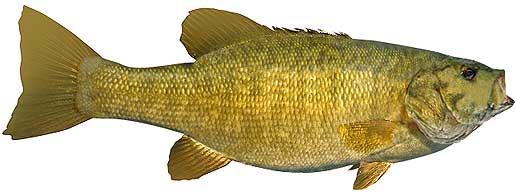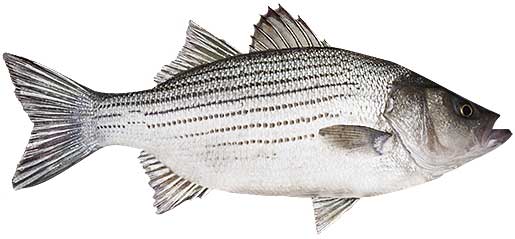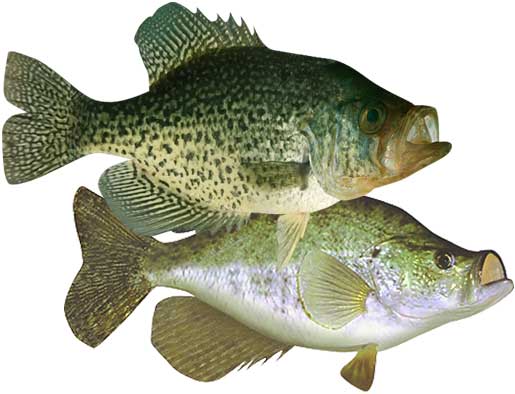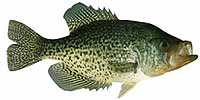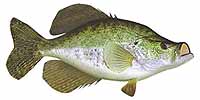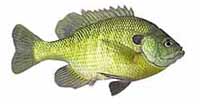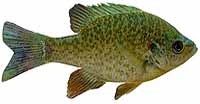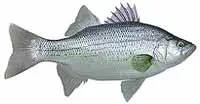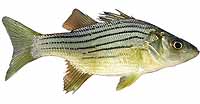Fishing Report For Barren River Lake, KY
By Rick Seaman
Last updated on .
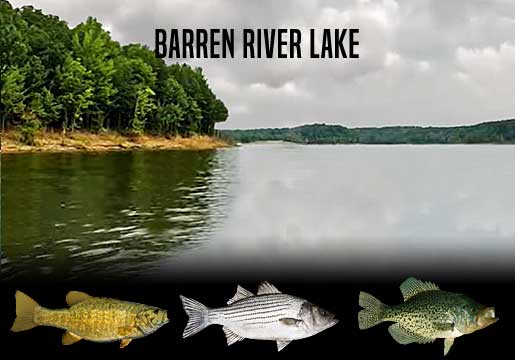
Fishing Reports
Popular Fish Species Barren River Lake, KY
Smallmouth Bass
Current Report: Good
FALL. As Fall arrives, smallmouth here follow schools of baitfish into coves and bays 3 to 15 feet deep. Smallmouth bass are not the most dominant bass on Barren River Lake, however they are the most fun to catch. They thrive in the cold, clean water, which is an ideal environment for them. Locals report that tube jigs are a great choice when the bass are in 15' or shallower. Drop shot rigs with small worms or shad shaped plastics are also popular in 10' water or deeper. Jerkbaits, deep-diving crankbaits, and slow-rolled spinnerbaits, are also successful, when bass are shallow to mid depth. Later in Fall, smallies move to slightly deeper water, around 10 to 20 feet deep. Fishing shallow for smallmouth is often good on cold, windy, cloudy and rainy days.
WINTER. Winter will isolate them around deeper structure, points, flats and creek channels, often suspending in open water above these features. They can generally be found from 15 to 35 feet deep. Jigging spoons, tube baits, drop-shot worms, jigs and Ned rigs tend to temp smallmouth in deep water. I like to work these deeper haunts very slowly, as the bass are somewhat sluggish. Here they hold, feeding less frequently, awaiting warmer water to return in Spring.
SPRING. After ice out, when water temperatures rise into the 50's, smallmouth move from deep wintering spots to shallower water, just outside spawning areas. They feed heavily in 3 to 12 feet of water at this time, and are typically caught on jerkbaits, crankbaits, tube baits, Ned rigs, and crayfish imitating plastics. Once water warms into the high 50's, they move into shallower water, and create nests in gravel or sand areas, then lay their eggs. Females then move to deeper water and males remain to guard the eggs, and then the fry. After a couple weeks, the males also move into 15 to 20 feet deep, and feed aggressively. Crankbaits, tube baits, Ned rigs, plastic worms, spoons and swimbaits are catching smallies during this period.
SUMMER. Smallmouth bass are currently feeding shallow early and late in the day in 5 to 15 feet of water. They are being caught on topwater, crankbaits, swimbaits, Ned rigs and tube baits. Smallmouth bass here feed on crawfish, gizzard shad, and small sunfish. They prefer rocky or gravel bottom areas, as this is where crayfish live. During the hotter parts of the day, they are being caught on points, humps, and ledges around 25 feet deep. Often these deeper fish tend to school, so finding them can deliver some fast action.
Hybrid Striped Bass
Current Report: Fair
Hybrid Striped Bass are stocked in Barren River Lake to give anglers another species to target, in this fertile water. The Kentucky Department of Fish and Wildlife Resources reports that late Fall and Early Winter are a great time to catch these wipers, for both size and numbers.
FALL. In Fall, hybrid stripers return to shallow water, the upper end of the lake, and into inflowing water if available. Early in the day wipers often chase bait to the surface and feed aggressively, making this an excellent time for topwater action. Mid day they move into 10 to 25 feet of water. Look for structure nearby deeper sections in channels, and fish them thoroughly. Most any lure that resembles shad will catch wipers at this time of year.
WINTER. In Winter, hybrid stripers again hang out in deeper water and feed close to the bottom, often 60 feet deep or deeper. Warm afternoons occasionally draw stripers shallower, so look for them around the 20-foot range as they feed on roaming schools of threadfin shad and gizzard shad. In late Winter, after ice out, it is important to locate schools of bait, then look for wipers schooling below the bait. Fish finders, and forward facing sonar, are a big help in locating these roaming schools. Nice fish are being caught while trolling or drift fishing. Spoons, swimbaits, blade baits, crankbaits, live bait and cut bait are typically effective this time of year. Due to slower metabolism, anglers are triggering more strikes by making slower presentations.
SPRING. When water temperatures rise into the mid 60's now, it's the ideal time for hybrid stripers to spawn. When the water temperature reaches 55 to 65°, they aggressively feed in the upper portions of the lake. There are plenty of hybrids averaging 2 to 3 pounds, with an occasional 5-pound plus fish being caught. In Spring, work wind-blown points, creeks, and the upper end of the lake if there is inflowing water. If they spawn, they will lay eggs in flowing water. Look for deeper holes in the river channels, as they are a good holding place for hybrid stripers after the spawn.
SUMMER. In Summer, these wipers typically hang out in 20 to 40 feet of water, staying close to schools of bait. Sometimes during the heat of the day they move close to the bottom, even deeper. Morning often draws hybrid stripers to much shallower water, so look for them around the 10 to 20-foot range as they feed on shallow, roaming schools of shad. Being successful at fishing for stripers in Summer is a matter of locating schools of bait, and the wolf packs of wipers are likely to be nearby. Fish finders, and sonar electronics, are a big help in locating these roaming schools. Nice wipers are being caught by casting, trolling or drift fishing. Live shad, spoons, blade baits, crankbaits, and cut bait are all effective here.
Black & White Crappie
Current Report: Fair To Good
KDFWR research reports that the crappie population is 50/50 black and white crappie. Fish habitat planted in the lake, brush piles and deep vegetation are popular crappie hang outs.
FALL. Baitfish, which are moving into shallow flats, coves and bays, are drawing crappie into these areas. They are feeding heavily in preparation for the cold Winter, in 5 to 15 feet of water. Minnows, hair jigs, and crappie jigs, fished 6 to 10 feet deep are catching crappie during this feeding marathon. Late fall starts the migration deeper, toward winter holding areas, for both crappie and baitfish. Small flutter spoons, fished in 15 to 25 feet of water, are a good option during this transition. Good results are coming around points, creek channels, and brush piles.
WINTER. Once the shallows start cooling rapidly, crappie will migrate to deeper holding areas, mostly off shore. At this time they are typically caught using a very slow presentation, in 18 to 35 feet of water. Most are caught around deep brush piles, creek channel bends, submerged timber, and main-lake structure. If they are suspending in open water, they often relate to some cover, or structure change, directly below them. During warming trends, especially warm afternoons, they are drawn into 8 to 15 feet of water to feed.
SPRING. In early Spring, crappie begin staging in 3 to 12 feet of water, just outside spawning bays and shallow flats. Beaver Creek, Peter Creek, and Skaggs Creek are popular areas holding good schools of crappie. Spring is prime time to be on the water, as both black crappie and white crappie have moved shallow to spawn. At that time, they are typically caught in 2 to 8 feet of water. Vegetation, docks, brush and wood are where most anglers catch crappie using small crappie jigs or live minnows. After the spawn, crappie typically move outside the spawning area and hold on cover close by, in 12 to 20 feet of water. Once they move deep, anglers report success using fish finders and forward facing sonar to locate schools of crappie, which tend to stack vertically around cover. Light tackle, with 4 lb to 8 lb line, is a popular choice.
SUMMER. Water temperatures get quite warm, and crappie fishing is usually pretty good. They feed in 10 to 15 feet of water early and late in the day, until the hot Summer sun causes them to retreat to depths of 12 to 25 feet. Also, a few have embedded in the shade of slightly shallower vegetation. This is a good time to focus around brush piles, standing timber, deep lay downs, bridge pilings and deeper docks. Anglers are also locating schools of crappie hanging over deep structure and around creek channel edges, using fish-finder electronics.
Fishing Video
Fish species to fish for...
Guide to fishing for largemouth bass, smallmouth bass, spotted bass, channel catfish, blue catfish, black crappie, white crappie, walleye, bluegill, redear sunfish, white bass, yellow bass and hybrid striped bass at Barren River Lake in Kentucky.
 Barren River Lake has over 10,000 surface acres and 140 miles of shoreline. Barren River Lake offers fishing for three species of bass, both species of crappie, two species of catfish, walleye, bluegill, sunfish, hybrid stripers and white bass.
Barren River Lake has over 10,000 surface acres and 140 miles of shoreline. Barren River Lake offers fishing for three species of bass, both species of crappie, two species of catfish, walleye, bluegill, sunfish, hybrid stripers and white bass.
Primary fish species to catch
Click images for fishing tips and details about each species.
Today's Weather & Forecast
Public Boat Launch Ramps & Landings
Click here for boat ramps.
Marinas
Click here for marinas.
Fishing License
Click here for a Kentucky Fishing License.
Map - Fishing & Access
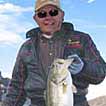 Rick Seaman is a fishing enthusiast with over five decades of fishing experience, a retired tournament fisherman, author of numerous published articles on fishing, and co-author of the book "Bass Fishing - It's not WHAT you throw, It's WHERE you throw it".
Rick Seaman is a fishing enthusiast with over five decades of fishing experience, a retired tournament fisherman, author of numerous published articles on fishing, and co-author of the book "Bass Fishing - It's not WHAT you throw, It's WHERE you throw it".
 Contact Information
Contact Information
Barren River State Park Marina
1148 State Park Rd
Lucas, KY 42156
270 646-2357
Fishing lakes in each state
102425
Barren River Lake, Kentucky Report
KENTUCKY


Information about fishing lakes in Kentucky
Barren River Lake, in south-central KY offers anglers the opportunity to fish for bass, crappie, walleye, hybrid stripers, catfish sunfish and white bass.


